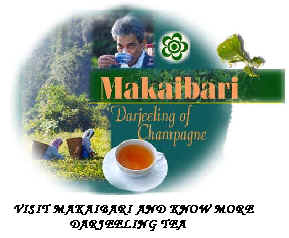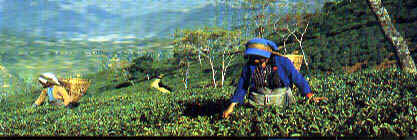| Green Leaf, which contains
78% to 80% moisture content when fresh is subjected to ivernight
period of placement in airy, dry space in the factory, where
oxidization of the moisture content can be done. This
is nothing but evaporation of the moisture content, to the extent
of 30% to 40% from the original state. This process is called withering.
The green leaf is placed
6-9 inches thick in a box-like frame of 70-80 feet long, about 5-6
feet wide and 3-4 feet high. There is a wire mesh fitted on the
top portion of the box and a high velocity axial fan is placed at
one end and started. Air pressure is forced into the box,
subjecting the leaf to a very strong pressure of air by which
comparitive uniform wither is achieved. This process is known as Withering
Through.
After withering, when the
leaf has become soft as opposed to the turgid green leaf in the
original stage of freshness, the withered leaf is subject to the
econd stage of manufacture called the Rolling. Here the
rolling machines roll and press the withered leaf without breaking
or cutting them. Rolling causes the cells inside the leaf to break
causing the juices inside the leaf to be pressed out thereby
laminating the outside surface. Normally two rolls of about 40
minute are given by varying pressure to express the juice. In
between the rolls, the leaf is subjected to sifting in sifting
machines which separates the corase leaves from the fine ones.
The third process is known
as fermentation. The rolled leaf, now covered with the
experssed juice and chemical constituents, is spread very thinly
on clean and impervious trays or racks in a high humidity room.
Here, the rolled leaf starts to develop the aroma, flavor and
other qualities by bio-chemical reactions. After the development
of required degree of"qualities," the fermented leaf
must be dried immediately to stop further fermentation. Over
fermentation or under-fermentation is harmful to the development
of proper characer of tea. This is where the art in tea-making
comes out.
The fermented
leaf is put in big automatic dryers. The leaf is fed at one end and
is spread on trays or conveyor belts that are constantly moving in
the chamber. Dry heat is forced through the chamber at about 240-250
degrees farenheit. At the other end, the leaf is dropped as ready
tea which now contains about 2%-3% moisture.

The last process is known as sorting. The sorting machines
grade the leaves into various grades. These are mainly the Leaf
Grade and the Broken Grades. Leaf Grades are long, wiry unbroken
ones which are graded as:
• The Golden Flowery Orange Pekoe or G.F.O.P
The brokens
are graded as:
• Golden Broken Orange Pekoe or G.B.O.P
• Orange Fannings or O.F
• Dust
|


